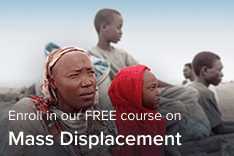Escalating conflict across the Middle East has precipitated yet another humanitarian crisis. The ongoing conflict, which began on October 7, 2023 when Hamas forces attacked Israeli farming communities, has expanded into Lebanon.
Perpetuating this cycle of violence, Iran recently fired at least 180 missiles into Israel. As of October 1, 2024, approximately 3 million people across Israel, Gaza and Lebanon have been forced to flee their homes and thousands more have been killed or injured.
World Relief has been providing emergency assistance alongside local partners in the region since October 2023. Our commitment to support those affected in Gaza, the West bank, Egypt and Israel has remained resolute. Now, as the situation has escalated, involving Lebanon and Iran, World Relief is expanding our reach into Lebanon. But we cannot do it alone. We need your help to assist those affected by this heartbreaking crisis.
As the situation evolves, the human toll will only get worse. Today, we’re answering five questions about the conflict in the Middle East and how you can help people in desperate need today.
1. What is currently happening in the Middle East?
The current wave of violence began on October 7, 2023 when Hamas forces attacked Israel from Gaza. Israeli forces responded immediately, and fighting in Gaza continues today.
While the war in Gaza has received ample news coverage, Israel has also been engaged in a conflict with Hezbollah at its northern border with Lebanon. Several key events have taken place and have led to the escalated situation you see today. Here is a brief timeline of those events:
- October 8, 2023 — Hezbollah forces in Lebanon launched rocket attacks against the north of Israel in solidarity with Hamas forces in Gaza. Israel responded with airstrikes in southern Lebanon.
- September 16-22, 2024 — Two significant events happened this week:
- Israel moved additional military assets from Gaza to its northern border near Lebanon
- A wave of attacks targeted Hezbollah members in Lebanon. You likely read about some of these attacks in the news which involved personal communication devices such as hand-held radios and pagers that exploded, killing more than 37 people and injuring 3,000. Though Israel has not claimed responsibility, it is widely believed they are responsible for these attacks.
- September 23, 2024 — Israeli air forces began bombing Hezbollah targets throughout Lebanon. Hezbollah also increased its rocket attacks on Israel.
- September 30, 2024 — Israel launched a ground invasion in Lebanon.
- October 1, 2024 — Iran fired at least 180 ballistic missiles into Israel.
2. Where is the conflict taking place?
The current conflict is centered around several points in Israel, Gaza and Lebanon.
Israel is a small country (about 8,630 square miles) on the coast of the Mediterranean Sea. It is bordered by Lebanon to the north, Jordan to the east and Egypt to the south. Palestine, which covers about 2,326 square miles, is comprised of two territories — the Gaza Strip and the West Bank — and is bordered by Jordan to the east.
3. Who is involved in this conflict?
Since October 7, 2023, multiple conflicts in the region are converging to create a dire humanitarian crisis. The conflicts involve a number of state and non-state actors including the governments of Israel and Iran as well as groups Hamas, Hezbollah and the Houthis.
The conflict has also had a catastrophic effect on civilian communities and humanitarian responders in Gaza, Lebanon, Yemen and Israel. The human toll has been unthinkable, and an urgent need for food, water, shelter and healthcare is rapidly increasing.
4. How many people have been affected?
As of October 1, 2024:
- The October 2023 attacks killed 1,195 people, including 851 civilians, and an additional 251 hostages were taken. It is believed that 97 hostages are still being held in Gaza. The rest have either been “released by Hamas, rescued by the Israel Defense Forces, recovered dead or killed in encounters”, according to NBC news reports.
- Retaliatory attacks by Israel have displaced more than 1.9 million Palestinians in Gaza, and more than 40,000 Palestinians have been killed.
- 60,000 Israelis have also been displaced from their homes in northern Israel as a result of fighting at the Israel-Lebanon border over the last year.
- Additionally, recent attacks have killed more than 1,000 people, injured over 6,000 and displaced more than 100,000 men, women and children in Lebanon.
The recent surge of displaced people in Lebanon has created a shelter crisis. Collective shelters are being set up across the country in schools and other public facilities to house the newly displaced people. Displaced people are also in need of food and basic necessities such as clothing, bedding and hygiene kits.
What’s more, the drastic increase of wounded people across Lebanon has severely impacted the health system which is struggling to keep up with the demand of people requiring trauma care. The Ministry of Health has ordered a halt on all non-emergent procedures across the country to prioritize those wounded in the strikes. The health system in Lebanon is in need of additional health supplies to meet the surging need.
5. How is World Relief Responding?
World Relief has been responding in Israel, Gaza, the West Bank and Egypt alongside local partners since October 2023. Over the last year, thanks to the generosity of people like you, we’ve been able to do the following through our partners on the ground:
- Provide food and clothing to more than 5,200 Palestinians and Israelis in Bethlehem and the West Bank
- Deliver medicine and essential supplies including insulin needles, water purification tablets, cancer medication and mental health support to 62,500 people in Gaza, the West Bank and Lebanon
- Bring spiritual, emotional and physical care to nearly 2,88 displaced Palestinians through a local Egyptian church partner. Church volunteers distributed food and clothing, supplied transportation to those crossing the border from Gaza to Egypt to seek medical attention, and provided emotional support to those affected by war and displacement
- Installed 50 latrines throughout Gaza, providing safe sanitation facilities to more than 2,500 people daily
- Installed three solar-powered filtration systems, giving 1,950 Gazans access to safe drinking water and basic sanitation
We continue to provide temporary shelter, medical supplies, clothing and bedding to families seeking refuge amid this terrible crisis. World Relief has a long history of working in the Middle East, including in Yemen and Jordan. We are heartbroken at the devastation caused by this current wave of violence. Our faithful church and NGO partners in the area are addressing the current needs and we’re ready to partner with them.
We refuse to turn a blind eye to this most recent wave of suffering. As humanitarians, we engage in these conflicts driven by a shared set of principles and are committed to providing aid to all those who need it, prioritizing the most urgent needs first. We stand in solidarity with all those who are suffering, offering practical aid and the hope of God’s love amidst unimaginable hardship.
Join us in praying for peace and mercy, and give now to support World Relief’s emergency response in the Middle East.


